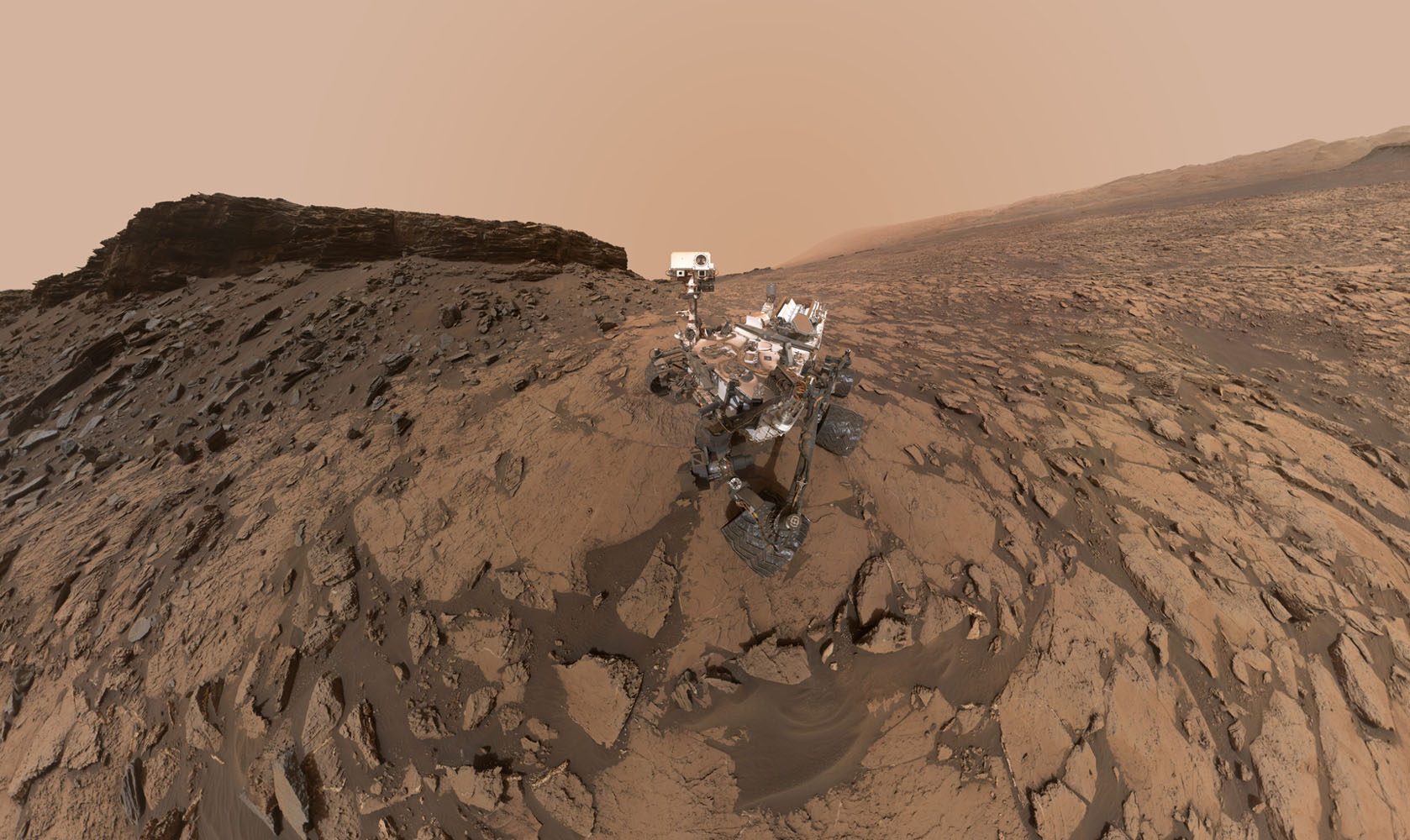
Ever since first landing in August 2012, the Curiosity rover has helped to revolutionize our understanding of Mars and has seen some incredible scenery along the way. It has travelled across an ancient lakebed and gazed at towering sand dunes and buttes, and now it is ready to begin the next phase in its mission: gradually ascending the lower slopes of Mount Sharp, the massive mountain sitting in the middle of Gale crater. The layers in the mountain will provide more clues as to how the Martian environment changed from being much wetter than it is now, to the dry but cold desert we see today. This next chapter in the rover’s mission is part of a two-year extension which began Oct. 1, 2016.
“We continue to reach higher and younger layers on Mount Sharp,” said Curiosity Project Scientist Ashwin Vasavada, of NASA’s Jet Propulsion Laboratory in Pasadena, Calif. “Even after four years of exploring near and on the mountain, it still has the potential to completely surprise us.”
Most recently, the rover just finished passing through a region of buttes called Murray Buttes, where the landscape could easily be mistaken for the American Southwest, except that there are no cacti or other types of vegetation around. Geologically, however, the region is quite similar, with sandstone rock outcrops and nearby mudstones. Even gravel has been found, similar to gravel in riverbeds on Earth; indeed, Curiosity confirmed evidence for ancient streams cutting through the crater walls and depositing the gravel where they had once fed into a giant lake or series of freshwater lakes which once filled Gale crater.
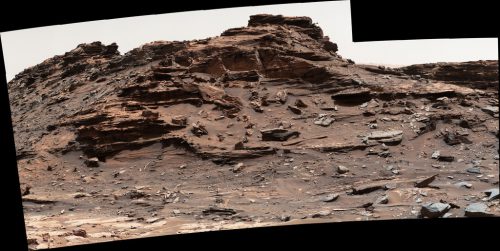
Murray Buttes is one of the most scenic areas visited by a rover so far. The many fine sedimentary layers in them will help scientists to better understand how Mars’ ancient climate and environment changed so drastically. But now, Curiosity is continuing on its journey.
“Bidding good-bye to ‘Murray Buttes,’ Curiosity’s assignment is the ongoing study of ancient habitability and the potential for life,” said Curiosity Program Scientist Michael Meyer at NASA Headquarters in Washington. “This mission, as it explores the succession of rock layers, is reading the ‘pages’ of Martian history – changing our understanding of Mars and how the planet has evolved. Curiosity has been and will be a cornerstone in our plans for future missions.”
Curiosity also just completed its latest drilling campaign—the 14th so far—near the base of one of the buttes, at a location called Quela. The first attempt had been halted prematurely by a short-circuit, but another attempt four days later was successful. This drill site is in a layer of mudstone about 600 feet (180 meters) thick, called the Murray formation. It is this mudstone which at one time was at the bottom of the Gale crater lake(s). Curiosity is literally roving across an ancient lakebed on Mars.
Evidence so far from Curiosity’s analysis of the drilled rock powder samples indicates that the lakes were relatively long-lasting. It was a much more benign environment as far as possible life is concerned, but whether or not this habitable environment was actually inhabited is still unknown.
“We will see whether that record of lakes continues further,” Vasavada said. “The more vertical thickness we see, the longer the lakes were present, and the longer habitable conditions existed here. Did the ancient environment change over time? Will the type of evidence we’ve found so far transition to something else?”
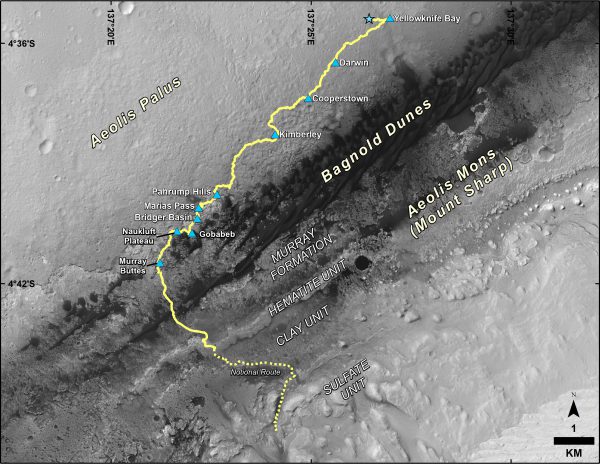
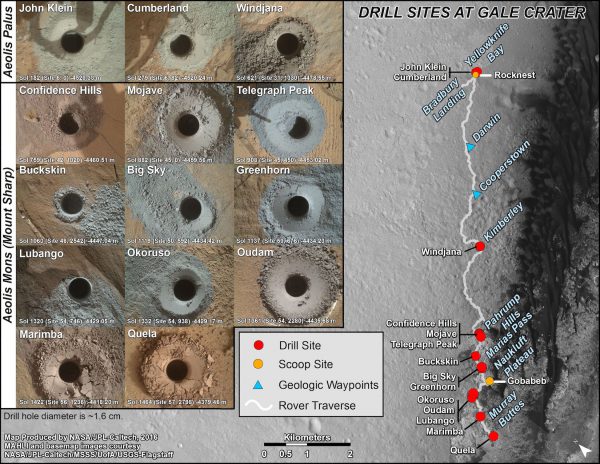
Just before Murray Buttes, Curiosity had passed through a region of massive sand dunes called the Bagnold Dunes. This dune field stretches partway around the base of Mount Sharp. The dark-colored dunes stand out starkly against the lighter landscape around them, reaching up to about two stories tall.
So what is next for Curiosity? Two regions up ahead are of particular interest. One is a ridge which is capped with material rich in the iron-oxide mineral hematite, about 1.5 miles (2.5 kilometers) ahead, and clay-rich bedrock beyond that. Both hematite and clays form in water-rich environment on Earth, so it will be interesting to see how analysis of material from those locations compares to those already studied. Both regions had been previously identified from orbit by the Mars Reconnaissance Orbiter. Clays also tend to point toward watery environments which were not too acidic or salty, which is what Curiosity has previously found near the base of Mount Sharp.
As Vasavada noted: “The Hematite and the Clay units likely indicate different environments from the conditions recorded in older rock beneath them and different from each other. It will be interesting to see whether either or both were habitable environments.”
This mission extension is now the second one for Curiosity, which will take the rover farther up the lower slopes of Mount Sharp, into another region of numerous buttes, mesas and canyons. Whether Curiosity will continue even farther up the mountain will depend on future mission extensions.
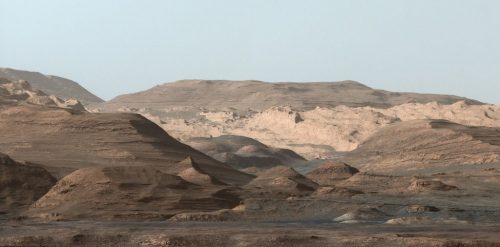
In another recent development, Curiosity has found evidence that the chemistry of the surface material on Mars has contributed to the composition of the atmosphere over time. Scientists have known for a long time that Mars has gradually lost most of its atmosphere, including, as found more recently, once-abundant oxygen. But these new findings show how Mars’ atmosphere has been more complex and dynamic. The findings were made by the Sample Analysis at Mars, or SAM, instrument suite on the rover, which examined the gases xenon and krypton.
“What we found is that earlier studies of xenon and krypton only told part of the story,” said Pamela Conrad, lead author of the report and SAM’s deputy principal investigator at NASA’s Goddard Space Flight Center in Greenbelt, Md. “SAM is now giving us the first complete in situ benchmark against which to compare meteorite measurements.”
The isotopes of those gases could have been released into the atmosphere by impacts or gas escaping from the rocky regolith on the surface.
“SAM’s measurements provide evidence of a really interesting process in which the rock and unconsolidated material at the planet’s surface have contributed to the xenon and krypton isotopic composition of the atmosphere in a dynamic way,” said Conrad.
The results of those experiments have been published in Earth and Planetary Science Letters.
Curiosity has made a lot of discoveries and the scenery has been spectacular, but it is time to keep moving on. The views as the rover moves into the foothills on lower Mount Sharp should be even better. Curiosity will be a mountain climber on an alien world.
“The only thing more stunning than these images is the thought that Curiosity will be driving through those lower hills one day,” said Vasavada. “We couldn’t help but send a postcard back to all those following her journey.”
More information about the Curiosity mission is available on its website.
Want to keep up-to-date with all things space? Be sure to “Like” AmericaSpace on Facebook and follow us on Twitter: @AmericaSpace





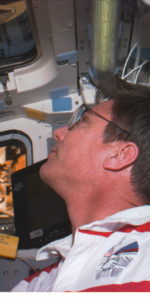
I sometimes wish I had studied geology and other sciences so I could better appreciate the findings of these planetary missions. Hopefully, some young minds will be inspired to do so.
I think it’s rusty ship there at M9a?
I think I can see through the veil of reality and that these images are questionable. Timelessness may be at work and the so called illusion of reality. It is possible that these images don’t exist. It is possible that the do exist but in a fairly safe way. Maybe the nature of reality isn’t understood enough at this time, maybe I’m dong things i shouldn’t be doing. i find these senses worrying. It’s so easy to express yourself but then that’s part of the question as to what life is all about.